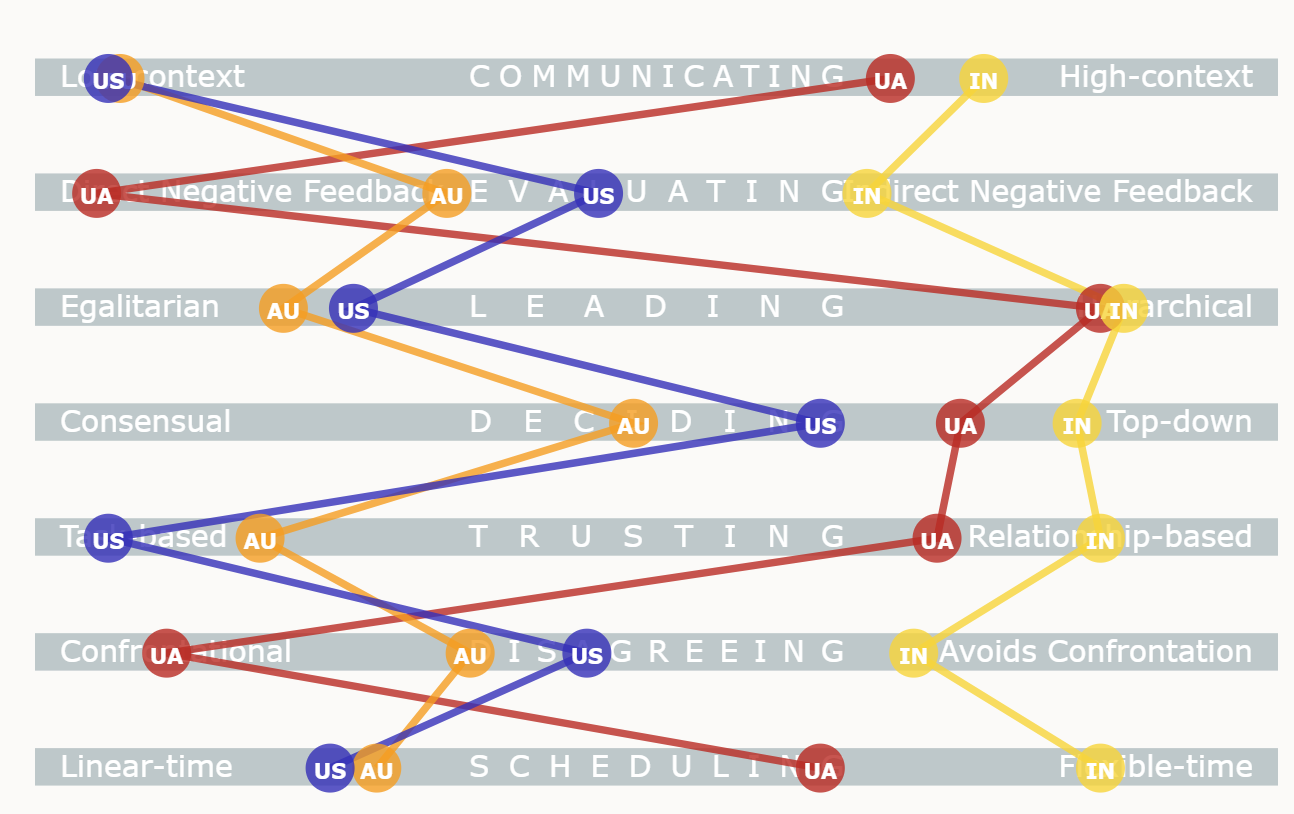SPS Commerce is headquartered in Minneapolis, MN and we have technology teams that span the globe in the following locations: Minneapolis, MN (USA), Little Falls, NJ (USA), Toronto, Ontario (CAN), Kyiv, Ukraine, and Melbourne, VIC (Australia) along with contracted teams in additional locations (India, Bulgaria, Mexico).
These team members are a blend of interns, part-time employees, full-time employees, and contracted team members. Some teams here work entirely within their local office, some have team members that span across a couple of locations and others span numerous geographic locations.

The Benefits of Global Diversification
The benefits to the business are relatively straightforward: There are generally cost benefits of having teams distributed across the globe. If done right, it can also provide 24/7 coverage and coverage during major holidays. When it doesn’t require late night and weekend on-call rotations, being able to continually ship code to production is a significant win for any tech team, whether that’s new deployments or bug fixes.
The benefits don’t end there. There are numerous ways that global diversity (and diversity in general) can have a positive impact on your team: People with different backgrounds innately bring different approaches and perspectives to how they solve problems. People with different backgrounds also tend to have learned how to code using different languages, best practices, etc. This can easily be seen as a “bad” thing at first blush. After all, wouldn’t life be better if we all thought and did things the same way? As it turns out, and there should be no surprise here, that’s not reality. Instead, the broader the experience and training sources, the more resilient your team will be when facing the inevitable onslaught of distinct issues that we all face in the world of working as part of a tech team. Even if it’s not an urgent issue that your team is trying to solve, having diversity in problem-solving types and programming training and education will allow your team to come up with more (and more unique) ideas for the various problems they are constantly trying to solve.
The Challenges We Face and How We Seek to Overcome Them
While all the above can be held as true, it would be doing a disservice to act like there aren’t complications that come with having globally distributed teams. The challenges are real, and some of them are outlined below, along with ways to overcome these challenges and barriers to succeeding as a global team in a global market.
Small Challenges
There are a lot of small things that are easy to not think about until you actually are confronted with them. For example, for something as commonplace as meetings/standups, there are all of the following things to consider:
- What A/V tech should you use for your meetings?
- What time of day works best for meeting across locations?
- Who should lead meetings / should you rotate meeting moderators across locations?
- … and the list goes on.
Not only do meetings pose additional questions and challenges to work through, but so does something as benign as what time of day it is in each office and how different offices participate (or don’t!) in Daylight Savings Time (DST). This impacts scheduling as it leads to varying amounts of overlap in working days throughout the year.
Planning is also complex. Every country has its own PTO/leave plans, observed holidays, sick leave policies, etc. Many of our tech teams work out of a scrum methodology. This requires a solid understanding of schedules for who will be in the office along with knowing which offices have upcoming holidays in order to plan and forecast work for future sprints effectively. How do we do this? Currently, we plan in a fairly old-school way: We ask for out-of-office notices posted to a shared team calendar, and team members use scrums as an opportunity to give others a general heads-up if they will be out for an extended period.
More Complex Challenges
We would identify the above challenges as small, not necessarily because they don’t require much thought. Rather, we term these small challenges because they are things that you have to think about and solve if you’re going to do work across a globally distributed team. There are more subtle and underlying challenges to working on globally distributed teams, too though. The more complex problems tend to arise from cultural misunderstandings, miscommunications, perceptions, etc.
We are working out of a framework and perspective that is inherently impacted by our culture of origin. Often, this is so second nature that it’s easy to make the (incorrect) assumption that everyone thinks, acts, and communicates in the same way. It can be easy not to notice or consider there may be cultural differences at play, and to quickly build assumptions or perceptions about others across the globe. This can be very harmful, as it has the potential to adversely impact our ability to work effectively and harmoniously across offices.
At SPS tech, we want to celebrate our cultural diversity and leverage it as an advantage for our teams. Nonetheless, cultural differences are real, and they shouldn’t be ignored. Therefore, we seek to address the potential challenges brought by global distribution head-on by asking our tech teams to complete a “Working on Globally Distributed Tech Teams” curriculum. The goal of this is to establish a common framework out of which we can seek to better understand our tech team members. It helps us all to remember that our own individual beliefs or even our own culture drive methods of thinking and acting that are not the best in every circumstance.
The training and framework give us a start to the ongoing conversation as to how to best do this “working on globally distributed teams” thing. Let’s explore this framework and the challenges it addresses a little bit more.
Working Out of a Common Framework
There are various frameworks for understanding cultural differences. The framework that we’ve found to be helpful is the “Culture Map” framework put forth by Erin Meyer in her book, The Culture Map. As detailed in this book, there are ultimately eight scales that summarize the various cultural differences faced when working with others from different cultural backgrounds:
- Communicating: Low-Context (Explicit) vs. High-Context (Implicit)
- Evaluating: Giving Direct vs. Indirect Negative Feedback
- Leading: Egalitarian vs. Hierarchical
- Deciding: Consensual vs. Top-Down
- Trusting: Task-based vs. Relationship-based
- Disagreeing: Confrontational vs. Confrontation-Avoiding
- Scheduling: Structured (Linear) Time vs. Flexible Time
- Persuading: Deductive vs. Inductive Reasoning (or: Concept-First vs. Applications-First Reasoning)
Below is a visual depicting where a handful of SPS’s global tech offices fall on the different culture scales. Countries represented: Australia, India, Ukraine, United States (locations chosen because they are the offices that I am the most familiar with).

NOTES:
- The scales above came from The Culture Map and was compiled by one of our Ukrainian team members. The country of Ukraine actually has never officially been “mapped” on the scale, but we have found that they are generally very close to Russia on each scale. We’ve confirmed with various Ukrainian team how we have their country mapped, and we have found these scales to be surprisingly accurate across the locations where we work.
- It’s important to note that the scale is relative. This means even countries that fall close to each other on any given scale, could see each other as being more or less “intense” than themselves on that same scale and would still think of the other culture as “different.” For Americans, this is evident across our Minnesota and New Jersey offices. We are alike but also different.
- The concept of persuasion as explained in The Culture Map only applies to Western Cultures, so it has been omitted from this chart. However, we do cover this scale during our training with more information around specific vs. holistic thinking when discussing the persuasion scale.
Much has been written to summarize the eight scales on the culture map, and it would take up a lot of space to reproduce that content here. For a good summary, check out this article by Gus Lubin from his 2015 Business Insider article, These 8 Scales Reveal Everything You Should Know About DIfferent Cultures. For our cultural training curriculum, we have combined summaries of each of the eight scales along with relevant real-life examples and proposed “strategies for success” while working across cultures within each of the scales (more to come on each of these in later posts). This allows us to identify areas where we have faced issues or challenges in the past, discuss why we ran into these issues/challenges, and start an open-minded dialogue with our team members around how we work and communicate together.
Does a Common Framework Solve All of the Problems?
No. It’s still easy to fall prey to thinking that the way we think, and work is the same across all offices. However, it is a start. The framework helps us to distance from thinking “I am right, all of the time.” It also has highlighted a few key “rules” that we would recommend following if you are working on a globally distributed tech team:
- Cultural differences are real, and you shouldn’t ignore them.
- Each culture acts out of their cultural norms. What is “right” within one culture might be “wrong” when working on a globally diverse team. The rule then is: Don’t assume your way of thinking and working is the best.
- Seek to understand others more than you expect them to understand you. Or, in other words: Seek to understand, not to be understood. Both will happen, but if your primary focus is being understood, then you’ll never truly understand your coworkers and you are ultimately working out of the assumption that your cultural preferences are the best, smartest, etc.
Each cultural perspective brings value to the table and can add a significant advantage for you and your tech team. After all, who really wants plain vanilla ice cream all of the time? Not us.